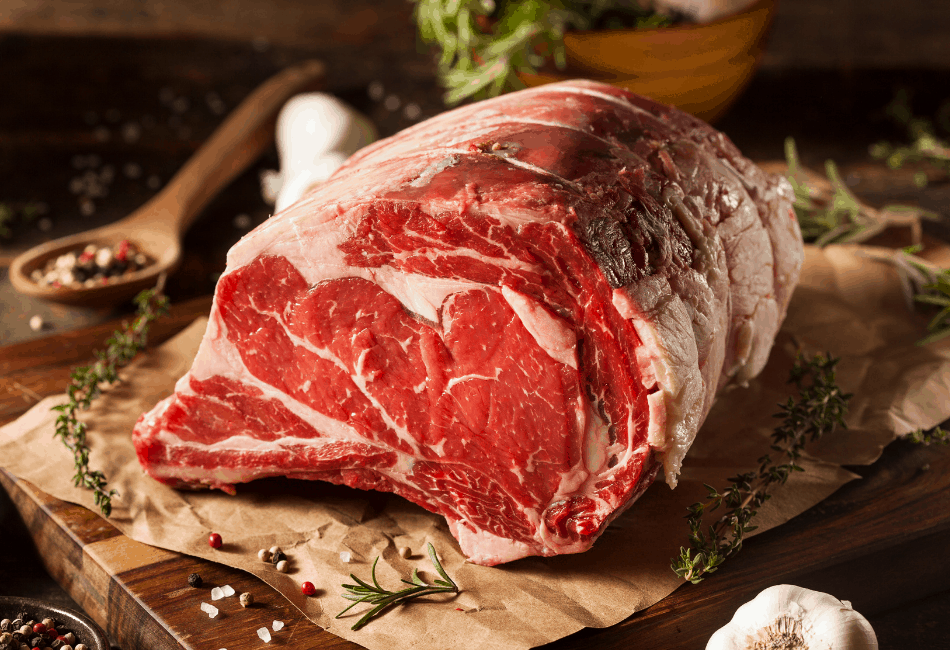- Southern Pride Mobile Smoker Review and Guide - November 12, 2021
- 3 Best Kosher Online Butcher Options For Convenient Supply - October 29, 2021
- Smoke Hollow Electric Smoker Review and Guide - September 17, 2021
When delving into the world of steaks it is hard to go wrong with a good prime steak or a nice marbled ribeye. These cuts are highly marbled in fat which makes them rich and juicy, the perfect way to treat yourself when you’re in the mood for a hearty steak dinner.
But what’s the difference between these two costly favorites? Let’s take a look at them individually and then go from there.
What’s the Difference Between Prime Rib vs Ribeye?
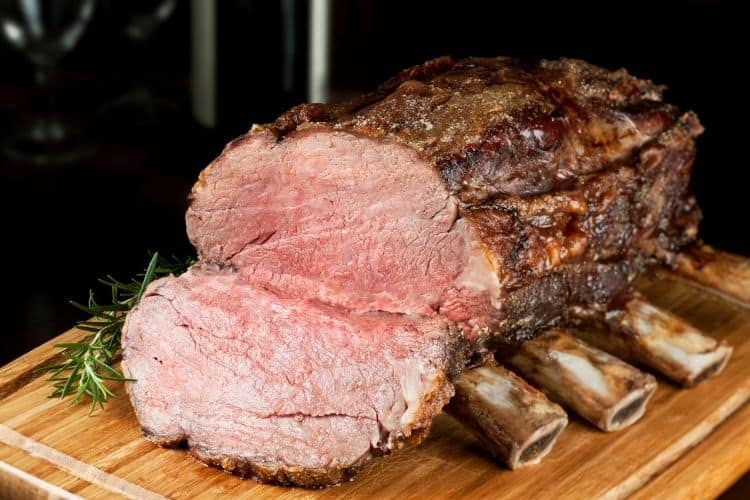
Only as you can see from our deep dive into these cuts they are, essentially, the same. They come from the same part of the animal, which is known as the primal cut, and they are basically only separated by their butchery and cooking methods.
The prime rib sits high up on the animal in the rib area where the muscles of the very little work which makes this cut particularly tender and juicy. If you couple this fact with its intense fat marbling and you’ve got a really juicy, flavorful piece of meat.
A ribeye steak is simply a portioned piece cut from the prime rib roast and deboned. This makes it possible to cook this cut in a frying pan to a hard sear rather than low and slow as a full rack.
This cut is one of those rarities that can be cooked using one method when its whole and a completely difference method when it has been portioned out with both results being juicy and delicious so you have a lot of choice when investing in a piece of meat this expensive.
The main differences at a glance:
- Prime rib is carved after cooking, whereas ribeye is portioned before cooking
- Prime rib is cooked low and slow, whereas ribeye is cooked with a quick sear
- Prime rib has a fat cap, whereas ribeye has a fat all the way around it
- Prime rib is cooked bone-in whereas ribeye is cooked boneless
- Prime rib is roasted in the oven, whereas ribeye is seared in a frying pan
A whole prime rib is referred to as a standing rib roast and consists of 7 ribs. Due to its size, one rack can serve 14 to 16 people with reach rib feeding approximately two people each as these thick cuts have a lot of meat on the bone. This makes a prime rib a treat-worthy holiday classic or the feature of any large roast dinner that can easily feed the whole family single-handedly. This cut is given its ‘prime’ status by being approved by the USDA based on the meat quality and the fat marbling. This USDA approval can cause a mark-up in prices of up to 50% because of its rarity and particularly flavorful and tender texture.
Prime Rib
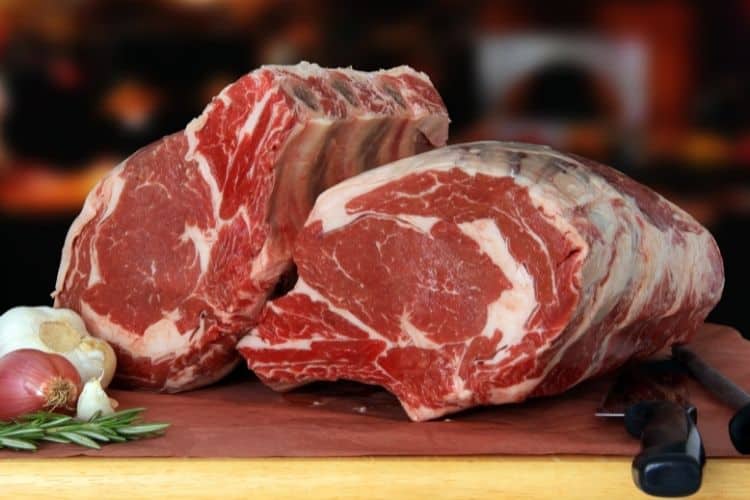
What’s the Best Way to Cook a Prime Rib?
Due to its considerable size this cut is best cooked low and slow so you get a delectably caramelised outside with a beautiful pink centre. The cut is usually trussed professionally to make the shape more uniform so it cooks evenly, this should be done for you when you buy it from a butcher but it is possible to try this yourself using a few online tutorials.
A deep roasting tray is the best vessel to cook this cut in to catch any of the excess juices that you can use for gravy later. The roast should be placed bone-side down as this lifts the meat off the surface and allows it to cook evenly the whole way around.
This also exposes the fat layer to direct heat so it crisps satisfyingly to create a luxurious mouth feel when you indulge in this delectable cut.
The best way to start off the cooking process is to begin with the oven on high and then reduce it to low so you get a good browning on the fat cap and start rendering it out by the end of the cooking process you will have a deliciously crunchy crust.
A good well-timed roast is rich and melts to juicy perfection on your tongue as it pulls apart with ease so this is what you’re aiming for when you tackle cooking something of this size.
The key to getting any meat, but particularly a cut of this size, to the right level of pinkness every time is to use a meat thermometer to measure the internal temperature.
To gauge this temperature correctly you should make sure to insert the thermometer into the very center of the meat and not close to the surface so you get a clear and accurate reading. For beef,
Recipe
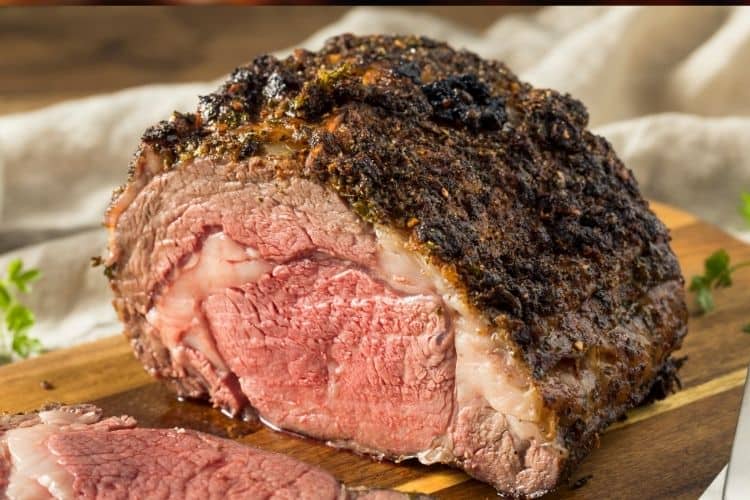
If you’re ready to tackle the mighty prime rib yourself then here is a simple but fail-safe recipe for you to start off with.
Ingredients
1 prime rib rack
2 tbl olive oil
1 tsp salt
1/2 tsp pepper
1 tsp dried rosemary
For the gravy:
1 clove crushed garlic
1/2 onion
2 tbl flour
1 tsp dried rosemary
Beef stock/milk
Method
- Before cooking bring the rack out of the fridge and let it come to the room temperature covered for an hour or so.
- In the meantime, preheat your oven to 500 F/ 260 C.
- Rub the rack on all sides with olive oil, salt, pepper and rosemary and place bone side down in a deep roasting pan lined with foil.
- Place in the oven at 500 F /260 C for 15 minutes.
- Now turn the oven down to 375 F/160 C for 10 minutes per pound. This is where your meat thermometer will come in handy so you can catch the meat at the perfect time if you are unsure about your cooking time calculations but try not to open the oven too often during cooking.
- Rest the meat loosely covered with foil for half the cooking time to retain the juices.
- While the meat rests make a gravy: Transfer the meat juices that have collected in the roasting tin to a frying pan and begin heating it. Add the onion, garlic, and rosemary and cook until the onions are translucent. Sprinkle in the flour, whisking until smooth. If it gets too thick or you want to stretch the gravy further you can add some milk or beef stock to get the ideal volume and consistency. Cook until thickened and season to taste.
- After resting cut the strings off cut the bones away from the meat as close to the bone as possible. Carve into thick slices and serve with roasted potatoes and your homemade gravy.
Ribeye
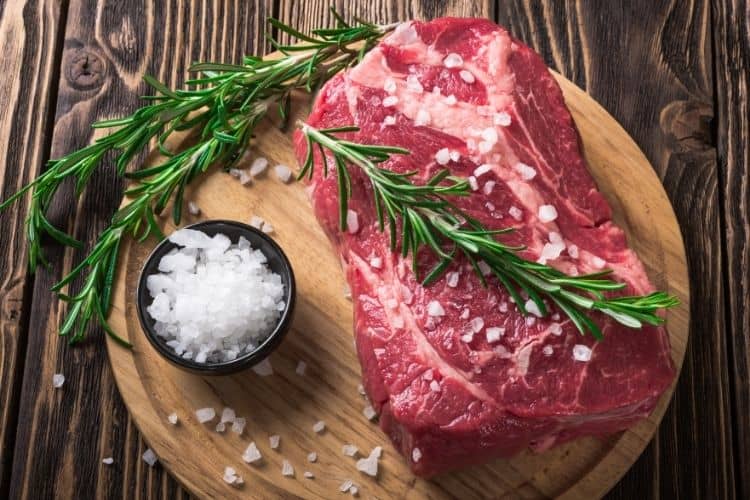
Surprise, the rib eye and the prime rib are in fact the cut! The prime rib is taken from high up in the chest cavity and has 7 ribs in total as we have discussed previously.
However, if you want to cook individual steaks quickly rather than a whole roast that can take a long time you can portion the prime rib down to 7 ribeyes which can each feed two people each due to the sheer size of these steaks.
These steaks are obtained by portioning each rib and then individually deboning them and trimming away any excess fat until only the marbled meat remains.
For the perfect ribeye you should, again, use the meat thermometer to obtain the perfect temperature. Your steak will read 120 C for medium-rare and should be rested to ensure that you retain its juices.
What’s the Best Way to Cook Ribeye?
A ribeye is best cook quick seared in a hot pan like a traditional steak. Placing it into a hot pan with butter and oil allows you to seal the cut on all sides and caramelize it to enhance its flavor while maintaining a delicious pink center.
Like the prime rib it is advised that you let the steaks come to the room temperature before cooking but this is not as essential with cuts like this that are thinner.
Recipe
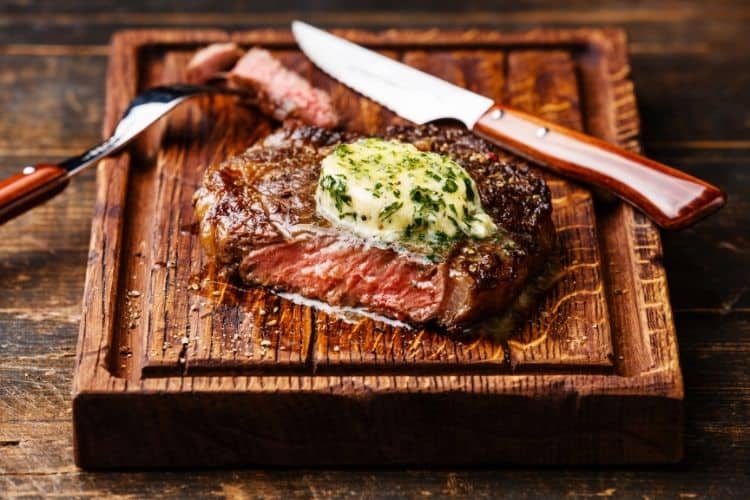
If you consider yourself a steak connoisseur and you are ready to tackle one of the most coveted steaks on the market then we have a great starter recipe for you that should help you show off your guests and display your meat cooking prowess.
Ingredients
1 ribeye steak
1 tsp olive oil
1 tsp salt
1/2 tsp black pepper
1/2 tsp dried oregano
1 tbs butter
fresh rosemary sprig
1 clove smashed garlic
Method
- Before cooking take the meat out of the fridge and let it come to room temperature.
- Place the olive oil into a pan and heat on high until smoking hot.
- Lay the ribeye into the pan and brown on both sides until golden, every 2-3 minutes.
- Turn the pan down to medium-low and push the steak to one side of the pan, tilting it slightly.
- To the lower half of the pan add the butter, garlic and rosemary then let them begin to infuse.
- Cook until the butter foams and then spoon over the steak for 2-3 minutes to baste the steak.
- Rest for 15 minutes before carving into 1/2 inch slices and serving with potatoes and maybe even a black pepper sauce.
Why are Prime Rib and Ribeye Expensive?
As we said before, these cuts are very tender because they are muscles that are used less than the legs for example. Only 8% of the animal is made up of tender cuts like this which makes them a rarity.
This means that butchers and supermarkets can mark up these cuts due to their tenderness, flavor, and scarcity. You may be paying a premium on these cuts but, if you cook them with care, the results will be totally worth it.
What Wine Pairs Best with these Cuts?
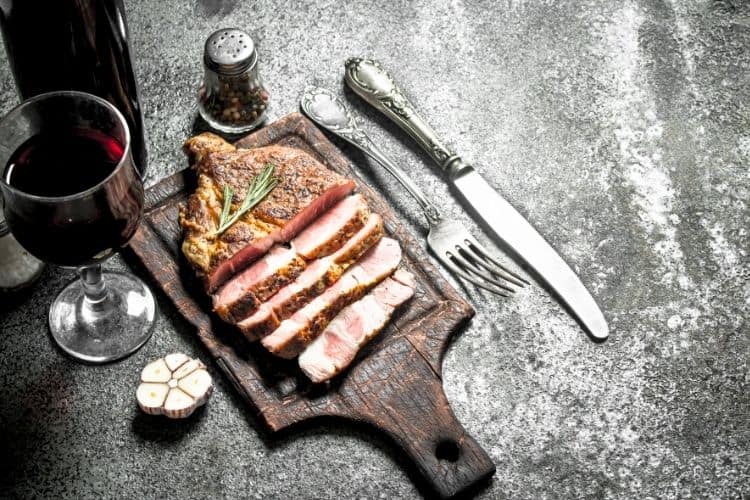
The perfect pairing is a prime rib or a ribeye is a cabernet sauvignon. Red wine works perfectly with red meat and the high tannins in this particular variation is perfect for cutting through the richness of fatty cuts like this.
FAQ
Question: If my Prime Rib doesn’t Fit in my Oven what should I do?
Answer: A standing rib roast is a very large cut so it is very likely that the whole thing won’t fit in your average domestic kitchen oven. In this case, you can split the roast in half before cooking with 3 ribs on one side and 4 on the other.
You can cook them concurrently in separate ovens if that is available to you or one after the other and heat the first up one you’re finished cooking the whole rack.
Question: What are the Correct Internal Temperatures for a Cut of Beef?
Answer: Generally speaking, these are the temperature you are cooking for when cooking beef in particular:
Rare 115 F 46 C
Medium rare 120 – 130 F 50- 55 C
Medium 140- 145 F 60- 63 C
Medium Well 150-155 F 65-69 C
Well Done 160 F 70 C
Question: Why must I Bring the Meat to Room Temperature before Cooking?
Answer: Leaving your meat out to eat the room temperature before cooking is an essential part of cooking a really juicy cut especially in larger cuts of meat like a prime rib. The basic logic behind it is that your meat will reach the desired internal temperature right at its center faster if it starts off the cooking process at a higher temperature.
This means that you can achieve the perfect level of doneness that you are aiming for without the meat on the outside becoming dry and overcooked. Taking precautions like this means that you’ll get a juicier result with a perfectly caramelised outside and a mouth-watering centre.
Please note that the meat must only be let out for as long as it takes to come to the room temperature and no longer as this will cause harmful bacteria growth.
Conclusion
When comparing these two cuts it really comes down to how much time you have and what you are in the mood for. We have discussed they are both from the same origin and their therefore flavor is elite either way.
If you are craving a traditional steak dinner then go for a nice big ribeye steak but if you are cooking for a group or having a celebration then a nice big prime rib is perfect! Whichever you are in the mood for a prime rib or a ribeye will never do you wrong.
You can purchase these cuts from your local butchery or even order them online from specialized sites like Ratelli’s https://www.rastellis.com/?irclickid=0tnRvWSqnxyLW31wtI004TU5UkBRp9zS11qzVQ0&utm_source=Dotdash&utm_medium=affiliate&irg.
There are even meat specific subscription boxes like Butcher Box that delivers high-quality meat straight to your door. https://www.butcherbox.com/?utm_source=google&utm_medium=cpc&utm_campaign=&utm_content=107477806935&gclid=CjwKCAjwx8iIBhBwEiwA2quaq-af5LhnAYFJ4ScUw4-ZYgclid =
You may also check out our complete guide on the best online beef delivery services here!

